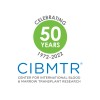
Cord Blood Transplant With Dilanubicel for the Treatment of HIV Positive Hematologic Cancers
Acute Erythroid LeukemiaAcute Lymphoblastic Leukemia10 moreThis phase II trial studies the side effects of a cord blood transplant using dilanubicel and to see how well it works in treating patients with human immunodeficiency virus (HIV) positive hematologic (blood) cancers. After a cord blood transplant, the immune cells, including white blood cells, can take a while to recover, putting the patient at increased risk of infection. Dilanubicel consists of blood stem cells that help to produce mature blood cells, including immune cells. Drugs used in chemotherapy, such as fludarabine, cyclophosphamide, and thiotepa, work in different ways to stop the growth of tumor cells, either by killing the cells, by stopping them from dividing, or by stopping them from spreading. Total body irradiation is a type of whole-body radiation. Giving chemotherapy and total-body irradiation before a cord blood transplant with dilanubicel may help to kill any cancer cells that are in the body and make room in the patient's bone marrow for new stem cells to grow and reduce the risk of infection.

IDH1 (AG 120) Inhibitor in Patients With IDH1 Mutated Myelodysplastic Syndrome
Myelodysplastic SyndromesAcute Myeloid Leukemiapatients with MDS (Myelodysplastic Syndrome) and mutated IDH1 patients will be treated with AG120 (IDH1 inhibitor)

Venetoclax and Azacitidine for the Treatment of Relapsed or Refractory High-Risk Myelodysplastic...
Recurrent Chronic Myelomonocytic LeukemiaRecurrent Myelodysplastic Syndrome3 moreThis phase I/II trial investigates the side effects and best dose of venetoclax when given together with azacitidine and to see how well it works in treating patients with high-risk myelodysplastic syndrome or chronic myelomonocytic leukemia that has come back (relapsed) or has not responded to treatment (refractory). Venetoclax may stop the growth of cancer cells by blocking some of the enzymes needed for cell growth. Chemotherapy drugs, such as azacitidine, work in different ways to stop the growth of cancer cells, either by killing the cells, by stopping them from dividing, or by stopping them from spreading. Giving venetoclax and azacitidine together may help to control myelodysplastic syndrome or chronic myelomonocytic leukemia.

HLA-Mismatched Unrelated Donor Hematopoietic Cell Transplantation With Post-Transplantation Cyclophosphamide...
Acute Lymphoblastic LeukemiaAcute Myelogenous Leukemia6 moreThis is a prospective, multi-center, Phase II study of hematopoietic cell transplantation (HCT) using human leukocyte antigen (HLA)-mismatched unrelated donors (MMUD) for peripheral blood stem cell transplant in adults and bone marrow stem cell transplant in children. Post-transplant cyclophosphamide (PTCy), tacrolimus and mycophenolate mofetil (MMF) will be used for for graft versus host disease (GVHD) prophylaxis. This trial will study how well this treatment works in patients with hematologic malignancies.

Venetoclax Basket Trial for High Risk Hematologic Malignancies
Myelodysplastic Syndromesde Novo15 moreThis trial is evaluating the safety and tolerability of venetoclax with chemotherapy in pediatric and young adult patients with hematologic malignancies, including myelodysplastic syndrome (MDS), acute myeloid leukemia derived from myelodysplastic syndrome (MDS/AML), and acute lymphoblastic leukemia (ALL)/lymphoblastic lymphoma (LBL). The names of the study drugs involved in this study are below. Please note this is a list for the study as a whole, participants will receive drugs according to disease cohort. Venetoclax Azacitidine Cytarabine Methotrexate Hydrocortisone Leucovorin Dexamethasone Vincristine Doxorubicin Dexrazoxane Calaspargase pegol Hydrocortisone

Treatment of Anemia in Patients With Very Low, Low or Intermediate Risk Myelodysplastic Syndromes...
Myelodysplastic SyndromesAnemiaAnemia in LR-MDS patients

CLN-049 in Patients With Relapsed/Refractory Acute Myeloid Leukemia (AML) or Myelodysplastic Syndrome...
Relapsed/Refractory Acute Myeloid Leukemia (AML)Myelodysplastic Syndrome (MDS)CLN-049-001 is a Phase 1, open-label, multicenter, first-in-human trial of CLN-049 in patients with Relapsed/Refractory Acute Myeloid Leukemia (AML) or Myelodysplastic Syndrome (MDS)

AMG 176 With Azacitidine in Subjects With Myelodysplastic Syndrome /Chronic Myelomonocytic Leukemia...
Higher Risk Myelodysplastic SyndromeChronic Myelomonocytic LeukemiaThe main objective is to assess the safety, tolerability, and efficacy of AMG 176 as monotherapy and in combination with the 7-day regimen of azacitidine for the treatment of Higher-Risk Myelodysplastic Syndrome and Chronic Myelomonocytic Leukemia (HR-MDS/CMML).

Efficacy and Safety of Canakinumab for the Treatment of Anemia in LR-MDS Patients
AnemiaMyelodysplastic SyndromesHematologic improvement of erythrocytes after 6 months of canakinumab treatment.

Fostamatinib for the Treatment of Lower-risk Myelodysplastic Syndromes or Chronic Myelomonocytic...
Refractory Chronic Myelomonocytic LeukemiaRefractory Myelodysplastic SyndromeThis phase I trial is to find out the best dose, possible benefits and/or side effects of fostamatinib in treating patients with lower-risk myelodysplastic syndromes or chronic myelomonocytic leukemia who have failed therapy with hypomethylating agents. Fostamatinib may stop the growth of tumor cells by blocking some of the enzymes needed for cell growth.
